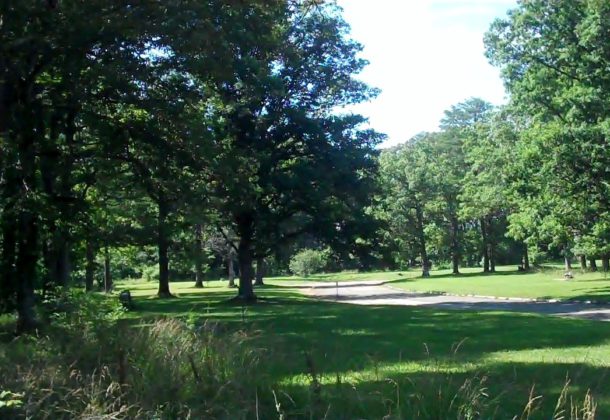The Flattops Evolve: Into a Tree Museum

While Joni Mitchell sang about a tree museum, Lexington Park, Maryland, grew one. Now St. Mary’s Community Development Corp. wants to save it.
Hundreds of Japanese flowering cherry trees and massive oaks reaching their three-quarter-century mark, fill 85 acres along Route 235 that were once Lexington Manor. Better known as The Flattops, the neighborhood in the heart of Lexington Park was razed in 2004, leaving the roads, vast lawns, and museum quality trees.
“It’s art,” said Roz Racanello, project manager of CDC efforts to develop public art projects. “And it’s a park,” she said to nods of slightly stunned agreement from members of the CDC’s Art Park Committee as they visited The Flattops in June 2016.
The upper 35 acres may take a bit of visualization to be convincing as art. Next door to the Lexington Park Post Office, this is an area in need of revitalization, far from the “swinging hot spot” replacing the trees Ms. Mitchell sings of. But the lower 50 acres are a place away. Away from everywhere.
The CDC formed the ad-hoc committee to explore ways to transform The Flattops property into an art park. The CDC hopes a less-intense, park-like use could better fit the density and revitalization goals of the Lexington Park Master Plan. Commercial redevelopment proposals for the property have failed to come to fruition.
The upper 35 acres consists of two nestling semi-circle roads that are significantly deteriorated and lined with cherry trees in need of attention. Beyond the cherry trees are the oaks and other scattered hardwoods that ultimately form a dense buffer across the back of the property.
In the lower 50 acres the roads are intact. Their curbs roll, occasionally crumbling, onto manicured greens that host an 18-hole, disc golf course. These roads, too, are lined by cherry trees. Lush grass runs through them to the toes of impenetrable stands of massive shade trees , thick enough to muffle the after-work traffic of Route 235 along the northern border.
The silence and fresh breeze surprised committee members who moved from the upper acreage to the lower 50; the disc golfers were quieter than the birds.
“I hadn’t remembered it was this wonderful,” said committee member Tom Watts.
To keep it this wonderful, the immediate need is to address the aging trees throughout the 85 acres, said arborist Carl Dyson. Possibly as many as 150 of the cherry trees can be saved, he estimated, but emphasized, the other hardwoods are just as important .
“We were simply wowed,” said Viki Volk, executive director of the Community Development Corp. “Seeing 50 acres of tranquil woodland, accessible roadways without vehicles, conducive to a stroll or a festival. We have a rare and valuable treasure right here, where we really need it, in the heart of Lexington Park.”























This is very exciting.